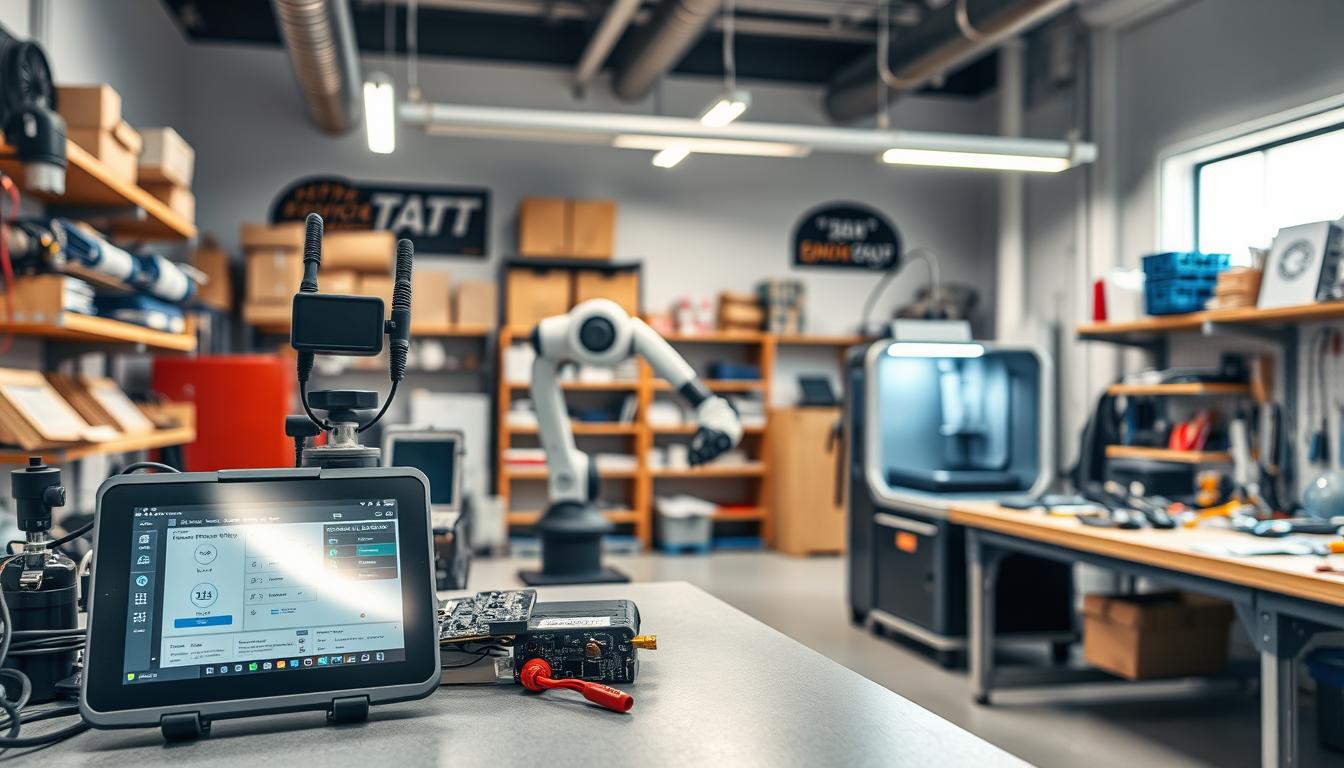Imagine Maria, a technician in Chicago, racing to fix a critical HVAC system on a sweltering summer afternoon. Just two years ago, her day was a blur of paper work orders, phone calls, and guesswork. Today, her tablet pings with real-time diagnostics, optimized routes, and customer history—all before she steps out of her truck. “It’s like having a co-pilot who knows exactly what we need,” she says. Her team now resolves 30% more jobs daily, and customer complaints have dropped by half.
Maria’s story isn’t unique. Research shows 74% of mobile workers face higher customer expectations than ever. Traditional methods struggle to keep up. But teams using advanced tools report faster response times and fewer errors. In fact, 83% of workers say these systems help them focus on what matters: the customer.
The shift goes beyond efficiency. Companies now predict issues before they occur. AI analyzes equipment data to schedule maintenance proactively. GPS and machine learning optimize routes, saving fuel and time. This isn’t just about doing things faster—it’s about doing them smarter.

Key Takeaways
- 74% of mobile workers report rising customer expectations, driving demand for faster solutions.
- Proactive maintenance models reduce downtime and boost customer trust.
- AI and machine learning optimize scheduling, cutting costs and improving productivity.
- Real-time communication tools enhance transparency between teams and clients.
- Businesses using automation scale operations without proportional cost increases.
Understanding the Landscape of Field Service Automation
Picture this: A repair crew in Dallas gets alerts about a malfunctioning elevator before tenants even notice. Instead of scrambling, they arrive with the right tools and parts—thanks to smart systems working behind the scenes. This is the new reality reshaping how teams operate.

What Does This Technology Do?
At its core, these systems act as digital assistants for teams on the move. They combine AI and machine learning to tackle repetitive jobs like assigning work orders or tracking inventory. Gone are the days when 68% of a technician’s shift was eaten by paperwork. Now, that time goes into fixing problems faster.
Where Are We Headed Next?
The latest tools don’t just react—they predict. Sensors in equipment can signal when parts might fail, letting crews schedule maintenance during slow periods. GPS data and traffic patterns automatically reroute vans to save fuel. One utility company slashed emergency call-outs by 40% using these proactive approaches.
Real-time updates keep everyone connected. Managers see exactly where teams are, while customers get precise arrival times. “It’s like watching a well-choreographed dance,” notes a operations lead from Phoenix. As platforms grow smarter, they learn from past jobs to make future decisions sharper—no human input needed.
Key Benefits for Operations and Customer Satisfaction
Think about the last time you waited for a repair technician. Frustration builds as minutes tick by with no updates. Now imagine a world where every step of that process works like clockwork. That’s the power of modern operational tools.

Increased Efficiency and Reduced Costs
Teams using smart scheduling systems handle 25% more jobs daily. How? Algorithms assign tasks based on location, skill sets, and urgency. One plumbing company cut fuel expenses by 18% simply by optimizing routes.
Inventory management gets smarter too. Sensors track parts usage and auto-order replacements before stock runs low. No more rushing to suppliers or paying premium prices for last-minute deliveries.
Enhancing Customer Experience through Real-Time Updates
Gone are the days of guessing when help will arrive. Clients receive automatic texts with technician names, photos, and live ETAs. “Knowing exactly when they’d arrive changed everything,” shares a hotel manager in Miami.
Post-service surveys show 89% satisfaction rates when teams provide progress alerts. Transparency builds trust—and repeat business. Happy customers become loyal advocates, driving referrals without extra marketing spend.
Essential Components and Tools for Modern Field Service
Managing a dispersed workforce requires precision. The right technology stack turns chaos into coordinated action, with each component playing a critical role.
Scheduling, Dispatch, and Routing Software
Think of dispatch platforms as air traffic control for technicians. These systems analyze skill sets, location data, and urgency levels to assign jobs in seconds. One Midwest plumbing company reduced drive times by 22% using live traffic updates and predictive routing.
Mobile Applications and Asset Service Management
Technicians now carry digital toolkits in their pockets. Mobile apps provide instant access to repair manuals, inventory levels, and customer payment histories. “I can order parts while standing in front of the broken equipment,” explains a veteran HVAC specialist. Asset trackers monitor equipment health, alerting teams before failures occur.
Integrations with CRM, ERP, and Analytics Platforms
When software talks across departments, magic happens. CRM links show a client’s past complaints during dispatch. ERP integration auto-reorders parts when stock dips. Analytics dashboards reveal patterns—like why Tuesdays have 30% more emergency calls. These connections turn raw data into smarter decisions.
Field Service Automation Best Practices for Implementation
What separates successful tech upgrades from costly misfires? It’s not just about choosing flashy tools—it’s how you roll them out. Companies that nail their transitions start by mapping their unique needs to the right solutions.
Developing a Tailored Implementation Plan
Begin with a deep dive into current workflows. Identify where delays pile up or errors creep in. A Midwest energy provider discovered 42% of their delays stemmed from manual data entry—a perfect target for streamlining.
Assemble a cross-functional team: IT experts, frontline managers, and technicians. This mix ensures the system works for everyone. One HVAC company reduced setup time by 35% by involving technicians in software testing early.
Launch small-scale pilots first. Test new tools in one region or service line. Adjust based on real feedback before expanding. This phased approach builds confidence and uncovers hidden snags.
Employee Training, Support, and Ongoing Optimization
Not all staff learn the same way. Create role-specific guides—dispatchers need dashboard mastery, while technicians focus on mobile app features. “Short video demos helped my team more than manuals ever did,” shares a construction fleet manager.
Track progress with clear metrics like job completion rates or customer satisfaction scores. Update workflows quarterly using these insights. Remember, even the best systems need tweaking as business needs shift.
Celebrate wins to drive adoption. When a telecom company spotlighted crews hitting 95% on-time arrivals, others followed suit. Keep refining—the finish line’s always moving forward.
Conclusion
Adopting advanced tools isn’t just an upgrade—it’s a survival strategy. Teams equipped with smart scheduling and mobile tech resolve issues faster while cutting costs. One logistics company saw 40% fewer delays after implementing real-time tracking systems.
These innovations transform how businesses operate. Predictive maintenance and route optimization create smoother workflows. Customers enjoy accurate ETAs and transparent communication, building lasting trust.
Looking ahead, AI will refine decision-making processes. Machine learning analyzes patterns to prevent equipment failures before they occur. Early adopters gain clear advantages in customer retention and operational agility.
Delaying modernization risks losing ground to competitors. The evidence is clear: organizations embracing these changes outperform peers in efficiency and satisfaction metrics. Now’s the time to act—future success depends on today’s choices.
See how FieldAx can transform your Field Operations.
Try it today! Book Demo
You are one click away from your customized FieldAx Demo!
FAQ
How does automation improve efficiency in field operations?
Automation streamlines repetitive tasks like scheduling, dispatching, and tracking work orders. Tools like ServiceNow or Salesforce Field Service reduce manual errors, optimize routes, and free up teams to focus on complex tasks. This cuts costs and speeds up service delivery.
What role do mobile apps play in modern service management?
Mobile apps like Jobber or Housecall Pro empower technicians with real-time updates, customer history, and inventory access on-site. They improve communication, reduce paperwork, and ensure accurate data collection for better decision-making.
Why is integrating CRM platforms important for customer satisfaction?
Linking tools like HubSpot or Microsoft Dynamics 365 with service systems ensures customer data syncs seamlessly. Teams gain insights into past interactions, preferences, and service histories, enabling personalized solutions and faster issue resolution.
How can businesses prepare employees for new automation tools?
Start with hands-on training sessions and provide ongoing support through platforms like Lessonly. Encourage feedback to refine workflows. Highlight how tools simplify tasks—like automated scheduling—to boost adoption and reduce resistance.
What trends are shaping the future of asset service management?
Predictive maintenance powered by IoT sensors (e.g., IBM Maximo) and AI-driven analytics are key. These technologies anticipate equipment failures, optimize resource allocation, and minimize downtime, ensuring proactive rather than reactive service.
How do real-time updates enhance the customer experience?
Platforms like Zoho Desk or Freshservice send automated alerts about technician arrivals, delays, or job completions. Transparency builds trust, reduces follow-up calls, and lets customers plan their day around service visits.
Author Bio
Co-Founder & CMO at Merfantz Technologies Pvt Ltd | Marketing Manager for FieldAx Field Service Software | Salesforce All-Star Ranger and Community Contributor | Salesforce Content Creation for Knowledge Sharing






